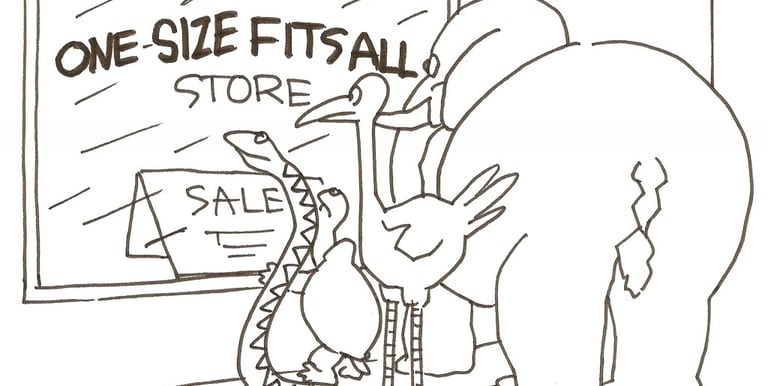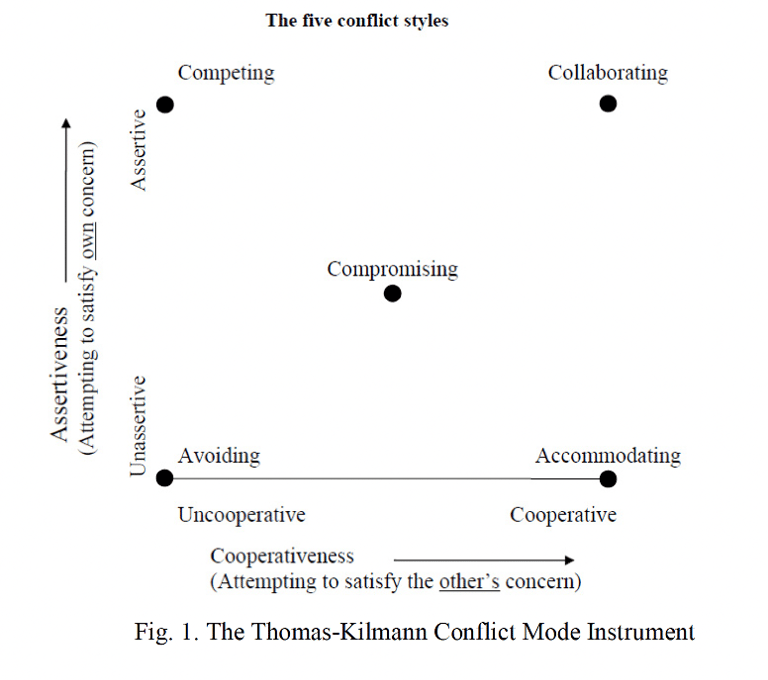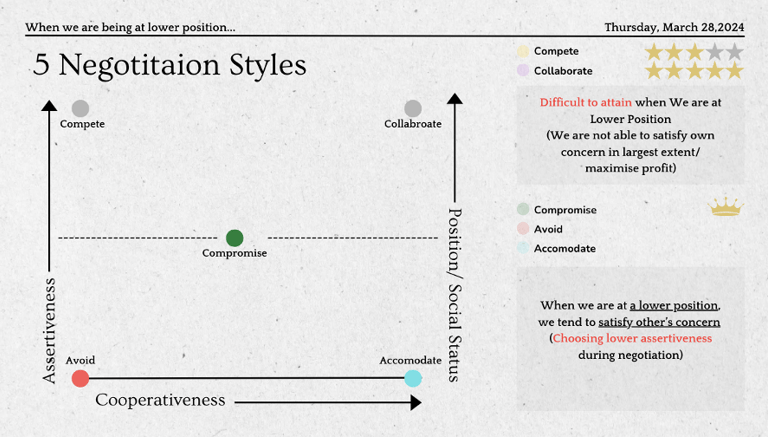Use Desktop for Better Experience
Management: How to Effectively Negotiate in a Lower Position? (Excerpt)
The report delves into the strategies and theories that facilitate negotiations for individuals situated in a lower position. The primary objective of the report is to acknowledge readers the importance of recognising one’s own position and the solution to take advantage of the lower position.
SOCIAL
Ryan Cheng, Alvin Cheng, Zoe Su
7/25/202410 min read
What is Negotiation Style?
Negotiation style is a person's behaviour or communication patterns employed in a negotiating setting to reach an objective (Lares, 2020). In a world with continuous improvements, human beings become more assertive and more intelligent in striving for their own desires. Uncivilised and impolite behaviours are no longer encouraged. Instead, humans choose to use negotiation to satisfy our interests. Negotiations occur in numerous situations, such as interpersonal interactions, family scenarios, workplaces and international relations. Good negotiation requires diverse skills: communication, critical thinking, problem-solving, and decision-making. Being able to utilise negotiation skills maximises the outcome of the negotiation by increasing the chances of gaining benefits.
Definition of Lower Position
A lower position is a management position at the bottom of the hierarchy in the chain of command with a lower salary (Nasrudin, 2022). Usually, individuals with lower positions deal with day-to-day operations and work supervision and are mostly involved in the production process. Individuals may take a lower position due to a few circumstances, for instance, career changes, job changes, and unemployment. Compared to individuals with high positions, those in lower positions will have relatively less authority, responsibility, and decision-making power.
Importance of Acknowledging Position in a Negotiation
The most critical phase needed to figure out before starting a negotiation is understanding the position situated in. Leveraging different negotiation styles to seek the most significant interest is crucial. An appropriate and attainable negotiation style enables the negotiator, who is situated in a lower position, to discover common ground or achieve mutually acceptable solutions. With a clear view and understanding of the situation and position, the negotiator can maximise the resources and effort to reach a favourable agreeable.
Importance of Research Topic
Situated in a lower position when negotiating is a common scenario. Being able to notice and effectively turn the table over allows us to generate positive results or not lose from the negotiation. Most researchers may neglect the aspects of every scenario, some theories are unattainable to achieve, due to unrealistic hypotheses of background information. Unbalanced negotiations happen in nearly every aspect of daily life, from project discussions with seniors to bargaining with our parents. Learning to overturn the situation is critical to win or not lose in all negotiation scenarios. Accordingly, the research can provide valuable insights and strategies for every person in both the aspects of personal and career development.
Problem Identification
The ability to negotiate effectively is crucial in a wide range of professional and personal situations. Negotiation is a fundamental skill for resolving conflicts (Chatterjee, 2021), making business deals, managing working relationships, and achieving personal or organisational goals. However, not all negotiation approaches are equally effective in every scenario, and choosing the wrong strategy can lead to suboptimal outcomes, damaged relationships, or failed agreements.




Short Term Wins Versus Long Term Relationships
Some negotiators tend to win at all costs, neglecting the long-term implications for the relationship between parties and not considering any long-term consequences. This negotiation style (competing) leads to a "win-lose" outcome where one party benefits at the expense of the other, potentially harming future collaborations and relationships.
Although lower-position negotiators might secure instant concessions, immediate benefits may not be sustainable. This is because choosing a negotiation style with a great extent of assertiveness, for instance, a competing negotiation style, could cause resentment or a sense of unfairness in the other party who stays in a higher position.
If the other party feels exploited or undervalued, they may be less willing to work with the lower position negotiator in the future, hindering future negotiation opportunities. Overemphasis on short term gains is detrimental to trust and goodwill building, indicating that it may not be the most advantageous approach in the long run.
“One-Size-Fits-All” Approach
The "One-Size-Fits-All" approach in negotiation refers to the use of a single, unchanging strategy regardless of the specifics of the negotiation situation . Many individuals enter negotiations with one single strategy, often one that mirrors their personal style or past experiences.
The approach is challenging for individuals being in a lower power position. When negotiators in lower positions apply a "One-Size-Fits-All" strategy, using an example of competing negotiation style, it could backfire if the party with a higher power position decides to walk away or use their position to impose terms.
It is possible for lower-position negotiators to benefit from a collaborative approach – seeking to expand the pie and create value for both parties, which is a win-win situation. Relying on a rigid and single negotiation style can limit their ability to explore alternative negotiation styles or make adjustments that could lead to a more favourable outcome. Every negotiation and scenario are not the same. Lack of flexibility can result in missed opportunities for better outcomes or dealing with conflicts.
Source: Compendian
5 Negotiation Styles
Negotiation styles have evolved and transformed throughout the decades. With reference to Appendix A, the negotiation styles focus on "concern for self" and "concern for others", which are the evaluation dimensions for every stage of negotiation styles. For our research, the 5 Negotiation Styles from Thomas & Kilmann (1976) are adopted and analysed.
Two essential dimensions of behaviour are used to define the 5 Negotiation Styles: assertiveness and cooperativeness. K.W. (2008) stated that assertiveness refers to the extent to which an individual attempts to satisfy their own concerns, while cooperativeness is defined as the attempt to fulfil other people's concerns. With reference to Appendix B, the Thomas-Kilmann Conflict Mode Instrument illustrates each negotiation style according to the abovementioned dimensions. The below explains each negotiation style in detail.


First, "Competing" means "I win, you lose". It is an assertive and uncooperative position. The negotiator must be power-oriented and hold control over the opponent. Negotiators prioritise their objectives ahead of others to secure their own concerns and wishes, protect their rights, and stick to their convictions.
Second, "Collaborating" means "I win, you win". Both assertive and cooperative are maximised in the setting. In order to collaborate with the opponent, working together is a must. The negotiator must work with the other person to find a solution that satisfies both concerns (Voss, 2022). To achieve and "Collaborating", the negotiators should explore differences and learn from each other's perspectives, in order to solve the problem in between. Otherwise, both should compete for resources and look for innovative and attainable solutions to ease the intergroup issue.
Third, "Compromising" means "I win or lose something; you win or lose something". It is a balance of assertiveness and cooperativeness, meaning that a balance is striked between both of the negotiators. Negotiators must understand that a 'Win-Win' situation is impossible, so both negotiators must come up with a workable and agreeable solution that partially meets both parties' needs. In addition, a middle ground is needed for the negotiators to come up with a “Compromising” outcome. The concept of "middle ground" refers to finding a balance or compromise between opposing viewpoints or positions (Tachikawa & Matsuo, 2023).
Fourth, "Avoiding" means "I lose, you lose". It is an unassertive and uncooperative approach. The negotiator chooses to escape from problems diplomatically and leave a dangerous situation behind. Gagliardi (2023) stated that when people face unsolvable problems or the advantages of not negotiating exceed the costs associated with time investment for the negotiation, some prefer to neglect both their own and other people's concerns and withdraw from the negotiation.
Lastly, "Accommodating" means "I lose, you win", which is the opposite of "Competing". Due to being in a position of weakness, some may feel forced to give in. It is sometimes preferable to lose rather than live to fight it. In this situation, the negotiator neglects their own concerns to satisfy other people's concerns.
Example of Real-life Scenario - Paris Climate Agreement
With reference to Overvest (2024), the Paris Climate Agreement demonstrates the effectiveness of the “Compromising” negotiation style. The agreement illustrates an excellent “I win or lose something; you win or lose something” situation, due to the following achievements.
Firstly, the participating nations distributed the tasks according to the extent of how much the nation has caused the issue. Then each negotiator bore responsibility that everyone could fulfil. Fair share was achieved to ensure equity.
Secondly, the ultimate goal is attained with contributions from every participating country. As a “win-win” situation was not feasible and possible in the situation, countries agreed to work together for the broader picture. The negotiators abandoned the wishes to solely win, the ultimate goal was instead preferred by the participating nations.
Thirdly, the agreement emphasised on checking and learning. Countries came to an agreement of monitoring each other and sharing research. The aim is to ensure the direction of the agreement and honesty of participating countries are achieved.


Analysis
From the real-world example mentioned above, the “Compromising” negotiation style contributed to the final positive outcome of the agreement. The below analyses how the aspects fostered a “I win or lose something; you win or lose something” situation.
As mentioned, “Compromising” emphasises the balance of assertiveness and cooperativeness. In other words, negotiators should come up with an agreement that satisfies both parties’ wishes while lowering the harm to any participants.
With the agreeable and workable solution in the Paris Climate Agreement, every participating country contributes their fullest to the issue. The nations prioritised the big goal ahead of individual wants, which is the most essential mindset needed to achieve a compromise within a negotiation. Thus, the countries understood if the agreement turned out a failure, no one would be benefited. Therefore, the countries were willing to sacrifice parts of wishes to achieve the larger picture together. Last but not least, freedom and respect were emphasised in the negotiation, as countries preferred voluntary acts rather than strict rules. This illustrates the requirement of the willingness of negotiators to sacrifice, in order to achieve an agreement.
Source: United Nations
Conclusion of Analysis
With the analysis of the real-world example, out of the five negotiation styles, “Compromising” is the most effective one for negotiators in a lower position.
Undoubtedly, every negotiator would prefer “Competing” and “Collaborating” outcomes due to the satisfaction of one’s own concerns. In contrast, compared to the other negotiation styles, “Compromising” is the most attainable and achievable for negotiators with limited bargaining power and control over opponents.
With three of the dimensions, the negotiation style is easier to identify for negotiators with different aspects. For instance, negotiators in high positions can achieve “Compete” and “Collaborate”, as more bargaining power and control is owned; oppositely, lower social status can only reach “Avoid” and “Accommodate”, due to the lack of authority.
With all being said, as “Compromising” being the balance of assertiveness and cooperativeness, the negotiation style is suitable for all positions of negotiators, especially negotiators situated in a lower position.
Recommendations
To handle the issues identified with negotiation styles more effectively, the following recommendations are provided. These suggestions are intended to guide managers in fostering a more versatile negotiation environment within organisations.
Managers should also be aware of being situated in a lower position as well. In specific scenarios, managers may have less control or bargaining power compared to their subordinates. For instance, the entire team voiced an objection to a decision made by the manager. Therefore, being in a lower position is extremely common for any individual in every possible scenario.
Balance Short Term Benefits with Long Term Relationships
Managers are recommended to encourage a collaborative negotiation style where possible, a “win-win” situation is undoubtedly the best for the both parties in a negotiation. Employees, who are more likely to be situated in a lower position, find it difficult to attain a “Competing” and “Collaborative” negotiation style as employees usually possess less resource and bargaining power.
In contrast, “win-win” situation is not applicable in all scenarios, unless the other party, who is situated at a higher position, is willing to collaborate with the party in a lower position. The negotiator with a higher position owns more bargaining power to promote “Collaborating” rather than other negotiation styles. With the focus on mutual interests and outcomes, the idea of “Compromising” should be encouraged. Managers can then reduce the negative impact of power imbalances and foster more equal and respectful negotiations. As winning something is always better than winning nothing.


Embrace Flexible Negotiation Styles
Employees should be trained to recognise and adapt to different negotiation styles based on the context, the other party's approach, and the desired outcomes. An understanding of one’s own situation and position is critical as well. As for the responsibilities of managers, the traits of each subordinate should be clearly identified and recognised, and employees should be constantly reminded of the negotiation styles.
By understanding the strengths and weaknesses of one's own, employees can modify the use of different negotiation styles, such as tending to be more cooperative and less assertive, by opting from “Competing” to “Compromising”, to fit the situation for constructive and better outcome.


Limitations - Scope of Research
With the limit on the number of pages, the main focus of the report lands on the 5 Negotiation Styles. The negotiation styles cannot solely solve the suggested topic, more techniques and theories should be adopted at the same time.
Therefore, for future research, more concepts and theories should be introduced and explained, to better ease the problem of being situated in a lower position.
Conclusion
In summary, effective negotiation from a lower position is a nuanced skill that requires an understanding of various negotiation styles and a strategic approach to relationship dynamics. As such, individuals and organisations should continue to refine these skills, tailoring their strategies to fit the unique circumstances they face. By doing so, they will be better equipped to achieve their objectives and foster positive outcomes in their negotiating endeavours.
Kennedy (1961) once stated “Let us never negotiate out of fear. But let us never fear to negotiate.” The fear within negotiation mainly comes from the unbalanced situation, so the report should act as a guide for negotiators to overcome the fear.




